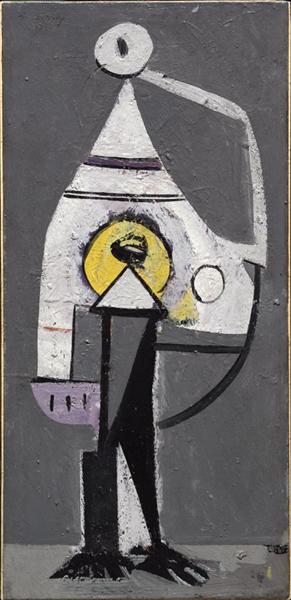Description
The painting "El Barbero (Composition No. 5)" by Arshile Gorky, created in 1933, is a fascinating testimony of modernist art and innovations that defined the artist's work in a crucial period of his career. Gatchy, a prominent representative of abstract expressionism, is characterized by his ability to merge the figurative with the abstract, generating a pictorial space in which emotions and experiences are prioritized above literal representation.
When observing "the barber", which immediately captures attention is the dynamic composition of the work. The painting evokes a scene that seems extracted from everyday life, where the figures are intertwined in a game of shapes and colors that challenge the conventions of classical realism. The arrangement of the elements on the canvas suggests movement, as if the figures were immersed in the action of hair cut, although their representation is schematic and stylized, leaving enough space to the interpretation of the viewer.
The use of color in this work is remarkable. Gorky displays a rich palette that ranges between vibrant tones and more mutated nuances. The tones of red and black dominate the scene, creating a dramatic contrast that evokes intense sensations. This chromatic approach is characteristic of Gorky, who was inspired by his Armenian background and the tradition of surreal art, merging emotionality with the precise technique. In "El Barbero", the color not only defines the figures, but also contributes to the atmosphere of the work; The warm tones seem to vibrate and establish a dialogue with the viewer, inviting him to enter this semiconscious world.
The character in the center of the work, which we could identify as the barber, is presented abstractly, which causes a feeling of blurring and at the same time closeness. The face and hands of the character are almost schematic, which underlines Gorky's emotional approach to representation. In this sense, Gorky seems to be suggesting that the experience of a haircut transcends the physical, becoming a ritual loaded with deeper meanings.
It is also important to consider the historical context in which Gorky works. Coming from an Armenian family that suffered the atrocities of genocide, its art often reflects a tension between personal trauma and the search for universal language. This duality is present in "El Barbero", where the everyday is mixed with the emotional, creating a narrative that resonates with pain and hope.
When comparing "El Barbero" with other works of the same era, parallels can be traced with the work of other modernist and surreal artists. The abstract and the figurative are intertwined in works by artists such as Juan Gris and Paul Klee, who also explored the relationship between shape and color. However, Gorky stands out for his ability to embed a deep sense of personal experience in his work, allowing each spectator to fall on his own emotional journey.
"The barber (composition No. 5)" is, therefore, a work that goes beyond the simple representation of a daily activity. It is an invitation to explore the complexity of the human condition, captured in a rich composition that challenges perception and understanding. Gorky's work reminds us that behind each seemingly insignificant action there may be a universe of meanings and emotions, a testimony of the deep impact that art has on our life experience.
KUADROS ©, a famous paint on your wall.
Hand-made oil painting reproductions, with the quality of professional artists and the distinctive seal of KUADROS ©.
Art reproduction service with satisfaction guarantee. If you are not completely satisfied with the replica of your painting, we refund your money 100%.

